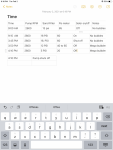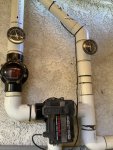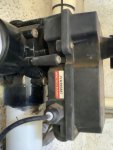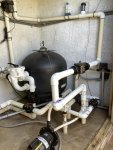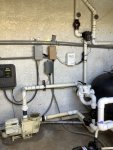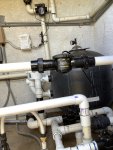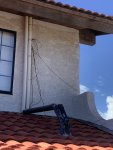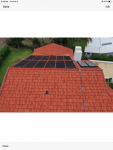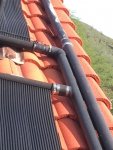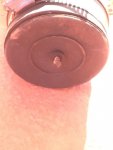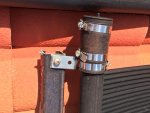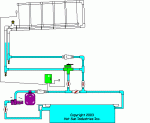Well, it's a bit late, but I can muster a few comments, about some weirdness I'm seeing. I'm not a solar expert or installer, other than my own system. But we can try to sort this out together.
It's my understanding that you must have a vacuum breaker in a rooftop solar system, or risk damage to the panels and/or the plumbing, especially the hot plumbing on the roof. So either it's missing and that might be related to your bubble problem, or you just haven't found it yet. Sometimes they are obvious, and sometimes they are semi hidden in the end of one of the panel manifolds up on the roof. I think it's important that you know for sure you do or don't have one, which might require a trip to the roof to inspect the four corners of the panel array. It could look like any of these (and maybe something else, too):

I see what looks like temperature gauges on both pipes to the roof. Someone was apparently interested in how much heat the panels were generating. That's fine, but not the best way to optimize your solar heater performance if that's what they were being used for. They're not standard, for sure. A properly tuned system would show a very small temp differential between those two locations, maybe 1 or 2 degrees. Which is likely well within the margin of error of either or both of those gauges. Which means you really don't know what the differential is, or if it's too much or too little. Contrary to logic, you don't want 5 or 10 degrees difference coming off the roof. That would indicate your system is not optimized and not heating your pool as well as it should, because the flow rate is too low (allowing the water to get too hot). The higher the flow rate the better, up to a certain point. You want a lot of slightly warmer water going into your pool, not a little of very hot water. The correct way to optimize your system is to first determine the optimal flow rate through the panels (as specified by their manufacturer) and then use a flow meter to dial in that optimal flow. I digress, we can come back to that if you're interested.
But the gauges are not the weird part. You have a check valve on the pipe leading
to the roof. That serves no purpose that I know of, and it should be located on the pipe coming
down from the roof. Let me correct that, that check valve might be serving to inhibit the way the system is supposed to work. Which is:
Solar panels are supposed to be empty when the pump is off. When the pump first turns on, the panels would still be empty. When the solar controller calls for heat and moves the solar valve to its "solar on" position, the panels fill with water. You'll should see a lot of bubbles of air coming out of the pool returns, almost like a jacuzzi. A lot of air! Once everything fills with water, the bubbles stop, and the solar system proceeds to heat your pool.
Say a cloud passes by, and the controller then turns off the system by operating the solar valve, because it senses there's not enough heat available, but the water would stay in the panels, ready for when the cloud goes away, the valve turns again, and water resumes flowing through the panels and heating your pool. With me so far?
But then at the end of the day, when the solar heater is done, and the main filter pump shuts off, the water must drain down from the roof. It exits the panels via two paths. A relatively small amount comes down the return pipe (in your system that's the one on the right). But most of it would come down the supply pipe (yours is on the left). The pipe on the right is always open to the pool. But the pipe on the left would run into the solar valve, which is not in its "solar off" position. A proper system utilizes a special three-way solar valve called a solar drain-down valve. It has a one-way component inside that opens when the main pump is off, that allows water to (you guessed it) "drain down" through the three-way valve. That water flows through the three-way and joins the water coming down the return line, on to the pool, until the panels are empty.
Now none of that draining can occur if air is not allowed into the system. Worse, the weight of the water trying to come down will suck on the panels and the pipes up on the roof, which might be very hot after a long day in the sun. And that suction can actually damage the panels and deform the pipes, sucking them in on themselves. Enter the vacuum breaker! That breaker "breaks the vacuum" and allows air into the panels and roof top plumbing (when it senses the pump is off), which allows all the water to drain down without stressing the system up top. That's how it's
supposed to work.
But here's the rub. If you're missing the breaker, the system might try to draw in air from somewhere else. I can't quite wrap my head around the possibility, but that might have something to do with the air getting into the pump. As if it's sucking so hard on the plumbing? I can't be sure about that. But the first step is to find the breaker, or confirm it doesn't exist.
But that's not even the weirdest part. It's that check valve on the supply side of your solar plumbing. Remember, most of the water that needs to come down off the roof will exit through the
supply side, and then through the solar drain down valve. But that check valve is not going to allow that. It is blocking the flow down that pipe! It only allows water to go up, not down. So I'm not sure what's going on with that, or why it's there.
It's possible that the plumber didn't want the water to come down for some reason. That the intention was to keep the panels full of water all the time. Which might explain the absence of a vacuum breaker, since if the panels never have to empty, there would be no need for one. But if that's the case, if that setup is a legit way to run a solar system, it is way beyond me, and not something I've ever seen described in all the research I did while building my system, nor in any of the schematic drawings I've viewed and used. Here's one that depicts a typical plumbing setup for solar. Note that your system is not this!
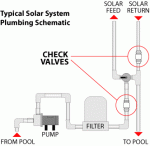
Not shown is the vacuum breaker. It's typically on the feed line (supply line), at least 6' off the ground, or on the roof, or sticking out of one end of a solar array manifold.
It's not definitive that any of your weird plumbing is causing the bubbles in the pump. One possible approach would be to redo your solar plumbing to a more standard configuration (move the check valve to the correct pipe and install a vacuum breaker if it is in fact missing) and see if that solves your problem. We can talk about installing a flow meter at the same time, and how that can help you get the most heat from your system, if you're interested.
If that doesn't help with the pump issue, then at least you've ruled that out and will end up with a properly plumbed solar system. You can DIY if you're up for it, I can assist as best I can, or you can call a local solar installer and have them replumb your system for you. If the latter, maybe before they do they can explain why your system is plumbed the way it is... Which I'd very much like to understand, if it's not incorrect like I think it is.
Let me know what you think and how you want to proceed...


